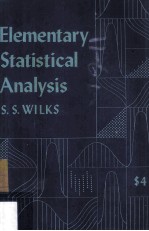图书介绍
Elementary Statistical AnalysisPDF|Epub|txt|kindle电子书版本网盘下载

- S.S.Wilks 著
- 出版社: Princeton University Press
- ISBN:
- 出版时间:1948
- 标注页数:284页
- 文件大小:45MB
- 文件页数:296页
- 主题词:
PDF下载
下载说明
Elementary Statistical AnalysisPDF格式电子书版下载
下载的文件为RAR压缩包。需要使用解压软件进行解压得到PDF格式图书。建议使用BT下载工具Free Download Manager进行下载,简称FDM(免费,没有广告,支持多平台)。本站资源全部打包为BT种子。所以需要使用专业的BT下载软件进行下载。如BitComet qBittorrent uTorrent等BT下载工具。迅雷目前由于本站不是热门资源。不推荐使用!后期资源热门了。安装了迅雷也可以迅雷进行下载!
(文件页数 要大于 标注页数,上中下等多册电子书除外)
注意:本站所有压缩包均有解压码: 点击下载压缩包解压工具
图书目录
CHAPTER 1.INTRODUCTION1
1.1 General Remarks1
1.2 Quantitative Statistical Observations2
1.3 Qualitative Statistical Observations6
CHAPTER 2.FREQUENCY DISTRIBUTIONS13
2.1 Frequency Distributions for Ungrouped Measurements13
2.2 Frequency Distributions for Grouped Measurements19
2.3 Cumulative Polygons Graphed on Probability Paper27
2.4 Frequency Distributions - General29
CHAPTER 3.SAMPLE MEAN AND STANDARD DEVIATION34
3.1 Mean and Standard Deviation for the Case of Ungrouped Measurements34
3.11 Definition of the mean of a sample (ungrouped)34
3.12 Definition of the standard deviation of a sample (ungrouped)36
3.2 Remarks on the Interpretation of the Mean and Standard Deviation of a Sample40
3.3 The Mean and Standard Deviation for the Case of Grouped Data42
3.31 An example42
3.32 The general case44
3.4 Simplified Computation of Mean and Standard Deviation48
3.41 Effect of adding a constant48
3.42 Examples of using a working origin49
3.43 Fully coded calculation of means,variances and standard deviations52
CHAPTER 4.ELEMENTARY PROBABILITY58
4.1 Preliminary Discussion and Definitions58
4.2 Probabilities in Simple Repeated Trials64
4.3 Permutations68
4.4 Combinations73
4.41 Binomial coefficients75
4.5 Calculation of Probabilities77
4.51 Complementation78
4.52 Addition of probabilities for mutually exclusive events78
4.53 Multiplication of probabilities for independent events79
4.54 Multiplication of probabilities when events are not independent;conditional probabilities81
4.55 Addition of probabilities when events are not mutually exclusive83
4.56 Euler diagrams85
4.57 General remarks about calculating probabilities90
4.6 Mathematical Expectation93
4.7 Geometric Probability95
CHAPTER 5.PROBABILITY DISTRIBUTIONS98
5.1 Discrete Probability Distributions98
5.11 Probability tables and graphs98
5.12 Remarks on the statistical interpretation of a discrete probability distribution101
5.13 Means,variances and standard deviations of discrete chance quantities102
5.2 Continuous Probability Distributions106
5.21 A simple continuous probability distribution106
5.22 More general continuous probability distributions109
5.3 Mathematical Manipulation of Continuous Probability Distributions111
5.31 Probability density functions - a simple case111
5.32 Probability density functions -a more general case113
5.33 Continuous probability distributions - the general case116
5.34 The mean and variance of a continuous probability distribution116
5.35 Remarks on the statistical interpretation of continuous probability distributions118
CHAPTER 6.THE BINOMIAL DISTRIBUTION122
6.1 Derivation of the Binomial Distribution122
6.2 The Mean and Standard Deviation of the Binomial Distribution125
6.3 "Fitting"a Binomial Distribution to a Sample Frequency Distribution128
CHAPTER 7.THE POISSON DISTRIBUTION133
7.1 The Poisson Distribution as a Limiting Case of the Binomial Distribution133
7.2 Derivation of the Poisson Distribution133
7.3 The Mean and Variance of a Poisson Distribution135
7.4 "Fitting"a Poisson Distribution to a Sample Frequency Distribution137
CHAPTER 8.THE NORMAL DISTRIBUTION144
8.1 General Properties of the Normal Distribution144
8.2 Some Applications of the Normal Distribution149
8.21 "Fitting"a cumulative distribution of measurements in a sample by a cumulative normal distribution149
8.22 "Fitting"a cumulative binomial distribution by a cumulative normal distribution152
8.3 The Cumulative Normal Distribution on Probability Graph Paper159
CHAPTER 9.ELEMENTS OF SAMPLING165
9.1 Introductory Remarks165
9.2 Sampling from a Finite Population165
9.21 Experimental sampling from a finite population165
9.22 Theoretical sampling from a finite population167
9.23 The mean and standard deviation of means of all possible samples from a finite population169
9.24 Approximation of distribution of sample means by normal distribution175
9.3 Sampling from an Indefinitely Large Population179
9.31 Mean and standard deviation of theoretical distributions of means and sums of samples from and indefinitely large population179
9.32 Approximate normality of distribution of sample mean in large samples from an indefinitely large population184
9.33 Remarks on the binomial distribution as a theoretical sampling distribution185
9.4 The Theoretical Sampling Distributions of Sums and Differences of Sample Means188
9.41 Differences of sample means188
9.42 Sums of sample means190
9.43 Derivations191
CHAPTER 10.CONFIDENCE LIMITS OF POPULATION PARAMETERS195
10.1 Introductory Remarks195
10.2 Confidence Limits of p in a Binomial Distribution195
10.21 Confidence interval chart for p200
10.22 Remarks on sampling from a finite binomial population202
10.3 Confidence Limits of Population Means Determined from Large Samples203
10.31 Remarks about confidence limits of means of finite populations205
10.4 Confidence Limits of Means Determined from Small Samples206
10.5 Confidence Limits of Difference between Population Means Determined Large Samples210
10.51 Confidence limits of the difference p-p1 in two binomial populations211
10.52 Confidence limits of the difference of two population means in case small samples212
CHAPTER 11.STATISTICAL SIGNIFICANCE TESTS216
11.1 A Simple Significance Test216
11.2 Significance Tests by Using Confidence Limits217
11.3 Significance Tests without the Use of Population Parameters219
CHAPTER 12.TESTING RANDOMNESS IN SAMPLES222
12.1 The Idea of Random Sampling222
12.2 Runs222
12.3 Quality Control Charts228
CHAPTER 13.ANALYSIS OF PAIRS OF MEASUREMENTS236
13.1 Introductory Comments236
13.2 The Method of Least Squares for Fitting Straight Lines240
13.21 An example240
13.22 The general case245
13.23 The variance of estimates of Y from X250
13.24 Remarks on the sampling variability of regression lines253
13.25 Remarks on the correlation coefficient255
13.3 Simplified Computation of Coefficients for Regression Line261
13.31 Computation by using a working origin262
13.32 Computation by using a fully coded scheme264
13.4 Generality of the Method of Least Squares272
13.41 Fitting a line through the origin by least squares273
13.42 Fitting parabolas and higher degree polynomials273
13.43 Fitting exponential functions276
INDEX281